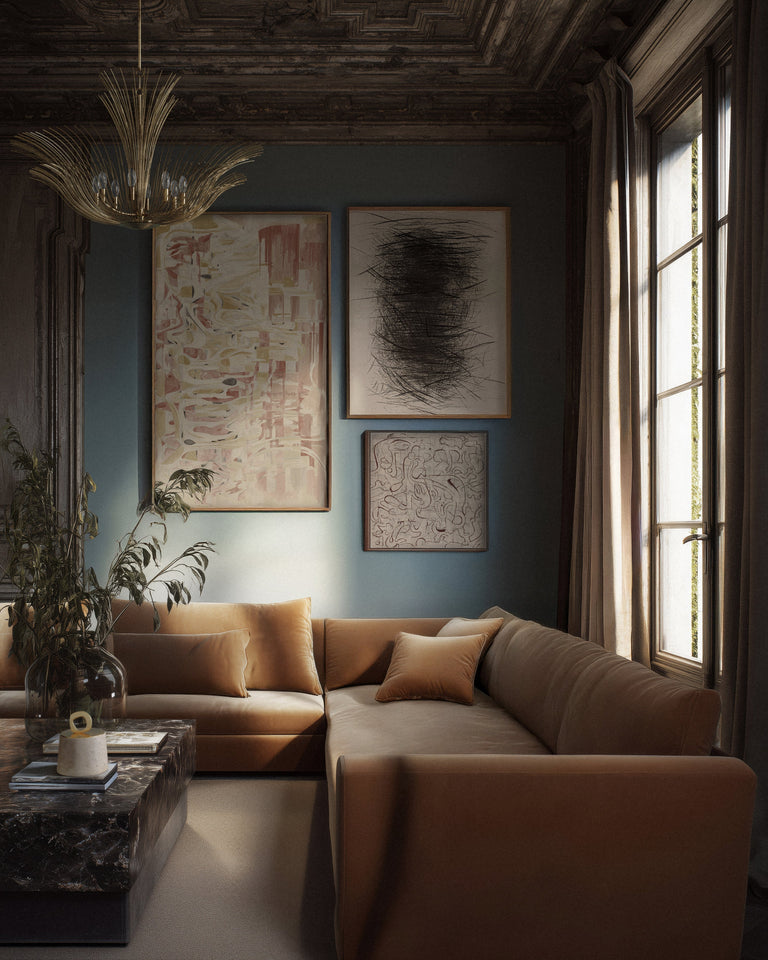
Lessons in Layering: The Art of Global Pattern Mixing
How centuries of textile tradition guide modern interior sophistication
In the grand salons of 18th-century Paris, where Madame de Pompadour held court beneath silk-draped walls adorned with intricate chinoiserie, the art of pattern mixing was already understood as a mark of true sophistication. French interior designers of the era, masters such as André-Charles Boulle and later, Jacques-Émile Ruhlmann knew what today's most discerning decorators are rediscovering: that the thoughtful layering of global patterns creates spaces of unparalleled depth and cultural resonance.
The Language of Global Textiles
The history of pattern tells the story of human civilization itself. From the flowing botanical motifs of William Morris that revolutionized Victorian England to the geometric precision of African Kuba cloth that has influenced artists from Matisse to contemporary designers, each textile tradition carries centuries of cultural knowledge. These patterns weren't merely decorative—they were expressions of identity, status, and artistic achievement.
The French understood this intuitively. In the silk-weaving ateliers of Lyon, artisans created damasks inspired by Byzantine traditions while incorporating motifs from newly opened trade routes to the Far East. It was pattern diplomacy, the peaceful exchange of beauty across cultures, woven into the very fabric of sophisticated living.

The Orchard, tapestry, designed by William Morris and John Henry Dearle, made by Morris & Co., 1890, England. Museum no. 154-1898. © Victoria and Albert Museum, London
The French Philosophy: Restraint Within Richness
What distinguished French pattern mixing from mere eclecticism was an underlying philosophy of restraint. Consider the work of Jean-Michel Frank, whose 1930s interiors combined primitive African art with refined French furniture, or more recently, Jacques Grange, who layers antique textiles with contemporary patterns in perfect harmony. Each pattern must earn its place, contributing to a larger narrative of sophistication.
This principle guides our approach at Lemieux et Cie. In our curated collections, we see the influence of these masters: from the botanical william morris patterns that echo the naturalism of French tapestry traditions to the geometric abstract art that recalls the mathematical precision of Art Deco design.
The Grammar of Global Pattern
Successful pattern mixing follows an intuitive grammar, much like the French language itself—complex but governed by elegant rules. Begin with what textile historians call a "foundation pattern", often geometric or architectural in nature. Think of the classic trellis motifs that have graced French gardens and interiors since the Renaissance, providing structure and rhythm to sophisticated spaces.
Layer in your "accent patterns", perhaps the flowing palm fronds that bring the organic sophistication of colonial French design, or the indigo African patterns that add depth and cultural richness. The key, as any French designer will tell you, is proportion and scale. Large-scale patterns anchor a space; smaller ones add texture and movement.
Cultural Threads: The Stories Patterns Tell
Each pattern in our global vocabulary carries its own narrative. The botanical traditions that emerged from 19th-century England brought nature indoors with unprecedented realism, while African textile arts like Kuba cloth and indigo dyeing techniques represent mathematical sophistication and spiritual significance that predates European contact by centuries. The geometric patterns found in Islamic art, so prized by French collectors, demonstrate how mathematical beauty transcends cultural boundaries.
These aren't simply decorative motifs; they're cultural artifacts that speak to humanity's universal desire to beautify our surroundings while expressing our deepest beliefs and aspirations.
From Salon to Garden: The Outdoor Revolution
The French have always understood that true elegance extends beyond interior walls. In the gardens of Versailles and the terraces of Provence, pattern played an equally important role through the geometry of parterres, the rhythm of pergolas, and the careful placement of textiles designed to weather the seasons.
Our outdoor collection embraces this heritage while addressing contemporary needs. Each pattern, from the botanical william morris that brings English garden romance to French terraces, to the ikat and indigo african motifs that add global sophistication to outdoor entertaining, is designed to create what the French call "une extension du salon", an extension of the living room beneath open skies.
These aren't merely outdoor fabrics; they're invitations to live more fully. The Kuba cloth-inspired geometries transform a simple terrace into a gallery of global craft, while our trellis patterns create the architectural framework that French designers have long used to define outdoor rooms.
The Artisan's Hand: Craft in the Age of Mass Production
The great textile traditions were built on the foundation of artisanal skill. The hand-block printing techniques that created the first William Morris wallpapers, the mathematical precision of traditional African weaving passed down through generations, the intricate resist-dyeing methods that produce authentic indigo patterns, these represent centuries of human knowledge and creativity.
This is why our approach to pattern honors both tradition and innovation. Whether it's a palm frond motif that recalls the French colonial tradition of bringing the exotic into the familiar, or geometric patterns that echo the mathematical beauty so prized by discerning collectors, each piece reflects our commitment to artisanal excellence.
Living with Pattern: The French Art of Effortless Sophistication
The secret to French pattern mixing isn't following rigid rules, it's developing what the French call "le regard", the eye. It's about understanding that a William Morris botanical can sing alongside African indigo when united by similar tonal values. It's recognizing that geometric patterns create dialogue rather than competition when they share an underlying rhythm.
In practice, this means starting with what you love and building slowly. Perhaps begin with our trellis collection, patterns that provide the architectural bones that French designers have relied upon for centuries. Add layers gradually: a cushion in botanical william morris, a throw in subtle geometric abstract art, perhaps a statement piece in bold African-inspired ikat.
The Future of Pattern: Global Craft Meets French Sophistication
As we look toward the future of interior design, the French lesson becomes even more relevant. In an increasingly connected world, the ability to thoughtfully combine patterns from different cultures isn't just aesthetically pleasing, it's culturally essential. Our outdoor collections embody this philosophy, bringing together the botanical heritage of English design, the geometric traditions of African craft, and the sophisticated restraint of French style.
Whether displayed on a Manhattan terrace or a Provençal garden, these patterns tell stories of global connection while maintaining the timeless elegance that defines true luxury. They prove that the art of pattern mixing, first perfected in those grand French salons, remains as relevant today as it was in Madame de Pompadour's time.
Because in the end, great pattern mixing isn't about decoration, it's about creating spaces that reflect the richness of human culture itself, layer by beautiful layer.
Discover our complete collection of Indoor/Outdoor Pillows, where centuries of textile tradition meet contemporary craft. From botanical William Morris to African-inspired geometries, each pillow represents our commitment to the artisanal excellence and cultural sophistication that defines Lemieux et Cie.
Recent Edits









